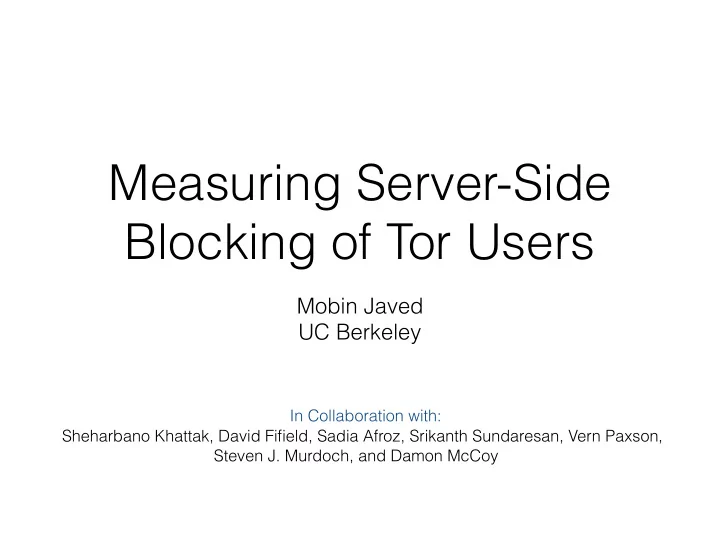

Measuring Server-Side Blocking of Tor Users Mobin Javed UC Berkeley In Collaboration with: Sheharbano Khattak, David Fifield, Sadia Afroz, Srikanth Sundaresan, Vern Paxson, Steven J. Murdoch, and Damon McCoy
The Perils of Selective Server-side Blocking Innocent users suffer due to fate-sharing • Blocking is generally abuse-based and/or utilizes third-party blacklists. • An important scenario: anonymity networks • Sometimes the only rescue tool for users in heavily- censored countries! 2
Example Frustrated me using Tor from China … Network layer blocking Application layer blocking 3
This Talk • Goal: Quantify server-side blocking of Tor at network layer • Experiment design & tool validation • Discussion: Modeling web-server “churn” 4
Experiment Design • High-Level: scan the entire Internet on port-80 from control nodes and Tor exit nodes. • Compare results Tools? ’Tis the era of ZMap! The Promise: Scan the entire Internet in under 45 minutes! 5
Validating ZMap Mitigating Measurement Loss • Does ZMap correctly send/report the packets? • Measure using experimental set-up • 6.7% packet drop at 1Gbps, throttle to 100Mbps • Multi-thread configuration buggy, use single-thread Full Internet Scan takes 7 hours 6
Mitigating Network Loss • Introduce probe-redundancy • Temporal churn for back-to-back scans: ~13% • Need redundancy at shorter-time scales • Use a delay of ~7 sec • Response rate improves by 1% Full Internet Scan takes 14 hours 7
Dataset • Run modified Zmap scans for seven days • 4 Tor exit nodes (USA, Netherlands, Romania) • 3 Controls (Berkeley, Michigan, Cambridge) • Scans at different locations synchronized in time • Success: {SYN-ACK} else Failure Average Hit Rate: 1.91% (~70 million web-servers) 8
Defining Web Footprint • Web-servers that respond varies across space and time even for control nodes! • Temporal Churn: up to 17% Differing responses over time for the same scan location • Spatial Churn: up to 3.7% Differing responses at the same time from different locations 9
Defining Web Footprint • RAW: Respond at least once from any location • LAX: Respond at least once from all control nodes • STRICT: Always respond from all control nodes RAW: 103 MILLION IP ADDRESSES (aggregated across one week) LAX: 96% of RAW STRICT: 50% of RAW 10
Discussion • Is there an underlying model for web churn? • Can we characterize various contributing factors? • What control-plane measurements can we use? 11
Questions 12
Recommend
More recommend